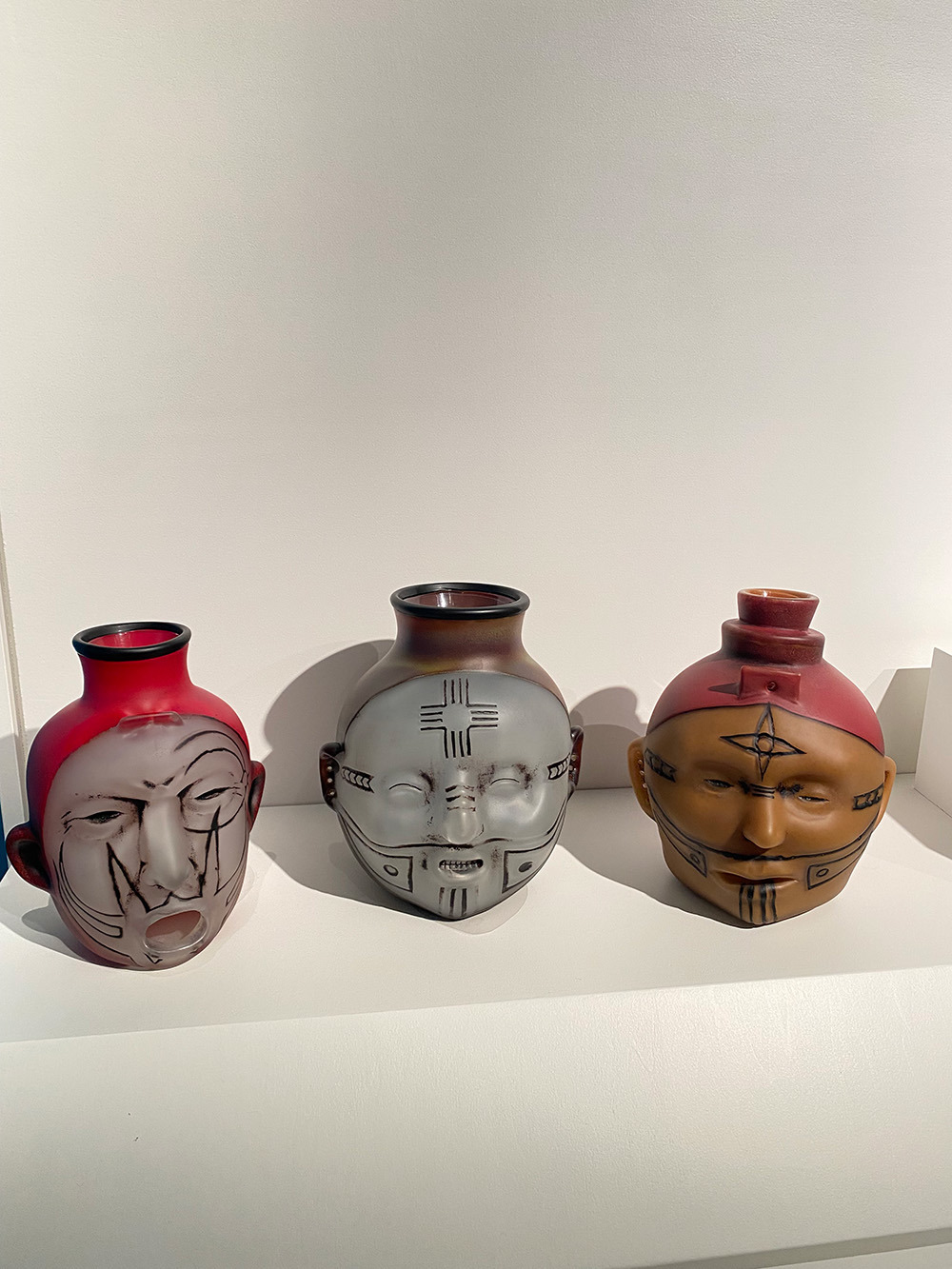Kill Bear, White Bear, and Morning Star

Kill Bear (Looks to the Sky), 2009, Marcus Amerman (American, Choctaw, b. 1959), Preston Singletary (American, Tlingit, b. 1963), 9 x 7 3/4 x 7 in. (22.9 x 19.7 x 17.8 cm), blown, sand carved glass, Collection of Preston Singletary, L10.2023:84
White Bear, 2009, Marcus Amerman (American, Choctaw, b. 1959), Preston Singletary (American, Tlingit, b. 1963), 9 3/4 x 8 3/4 x 8 1/2 in. (24.8 x 22.2 x 21.6 cm), blown, sand carved glass, Collection of Preston Singletary, L10.2023:85
Morning Star, 2009, Marcus Amerman (American, Choctaw, b. 1959), Preston Singletary (American, Tlingit, b. 1963), 10 x 8 x 8 1/2 in. (25.4 x 20.3 x 21.6 cm), blown, sand carved glass, Collection of Preston Singletary, L10.2023:86
Verbal Description
Hello, I’m Cole Rodgers, the museum’s project manager. I will be sharing the label for Out of Sight by Tammy Garcia in Clearly Indigenous: Native Visions Reimagined in Glass.
Kill Bear, White Bear, and Morning Star were created by Marcus Amerman, born in 1959, who is Choctaw, and Preston Singletary, born in 1963, who is Tlingit. The three works are blown and sand carved glass and are in the collection of Preston Singletary.
The three-dimensional blown and sand carved glass face vessels, Kill Bear, White Bear, and Morning Star, are located on the Balcony. They accompany two additional works in a wall case located to the right as you exit the main gallery. They appear, left to right, in the order they are presented here.
Kill Bear measures nine inches tall, seven and three-quarter inches wide, and seven inches deep, or 22.9 centimeters tall, 19.7 centimeters wide, and 17.8 centimeters deep. This ovoid vessel takes the shape of a human head. It is, overall, red in color with a short red neck featuring a black rim. The body of the vessel is dominated by a white face, its features outlined in black. The eyes of the face are squinting, and the mouth is open in the form of an “o.” Black lines ring the right eye and flame-like lines frame the mouth and move outward across the cheeks. The back of the head and ears are enveloped in red.
White Bear measures nine and three-quarter inches tall, eight and three-quarter inches wide, and eight and one-half inches deep, or 24.8 centimeters tall, 22.2 centimeters wide, and 21.6 centimeters deep. Created in a similar shape as Kill Bear, this face-shaped round vessel is mostly amber in color with a short amber neck featuring a black rim. The body of the vessel is dominated by a white face, its features outlined in black. The face is white with closed eyes, plump apple cheeks, and a small mouth open to show teeth. Black markings on the face include, on the forehead, a cross made of three lines with a circle in the center; on the bridge of the nose three horizonal lines; a straight line that runs under the nose and across both cheeks; four vertical lines on the chin, and a wedge shape on each cheek.
Finally, the work Morning Star completes the trio. Also, a face-shaped vessel, it measures ten inches tall, eight inches wide, and eight and one-half inches deep, or 25.4 centimeters tall, 20.3 centimeters wide, and 21.6 centimeters deep. This round vessel is mostly a deep orange with a short, round, double-stacked neck. This deep orange color extends onto the forehead and around the back of the head. On the front of the head is a small rectangular addition pierced with a small hole. The face and ears are ochre yellow. The eyes and mouth are closed, the lips creating a straight line—neither a smile nor frown. The facial markings are in black and include a four-pointed star on the forehead, three horizontal lines across the bridge of the nose, a straight line that runs under the nose and across both cheeks, four vertical lines on the chin, and a wedge shape on each cheek.
Label Audio
Hello, I’m XXXXX, the museum’s XXXXXX. I will be sharing the label for the works Kill Bear, White Bear, and Morning Star by Marcus Amerman and Preston Singletary in Clearly Indigenous: Native Visions Reimagined in Glass.
Kill Bear, White Bear, and Morning Star were created by Marcus Amerman, born in 1959, who is Choctaw, and Preston Singletary, born in 1963, who is Tlingit. The three works are blown and sand carved glass and are in the collection of Preston Singletary.
These three vessels were inspired by jars made of clay that were found in archeological digs of ancient villages of the Mississippian Culture. Marcus Amerman’s Choctaw tribe is one of the Indigenous Nations descended from the Mississippian Culture, also known as the Mounds Culture.
